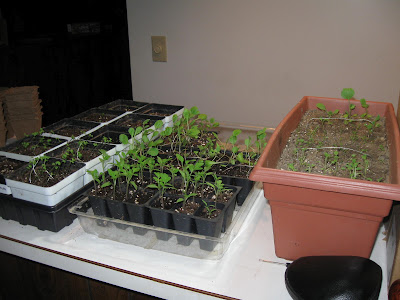Public Enemy No. 1: The Groundhog
I planted my cabbages in the garden recently, much to the delight of the groundhog, who quickly nibbled most of them to nubs before I got any deterrents into place. Thankfully that is all she has seen fit to devour thus far, but it is very frustrating.
The National Park Service is attempting to trap the groundhog, but after a week the miserable little rodent is proving too smart to take the bait.
For now my best line of defense is sprinkling bloodmeal on the ground in each of the vulnerable beds. It seems to be working for now, though perhaps she has simply already eaten the choicest greens and will wait to return for more.
I intend several other tactics to repel furry pests of all stripes. This will include spraying vulnerable greens with cayenne pepper water, planting mints, calendula (pot marigolds), borage, or other plants which may discourage pests, and placing cotton bags of pet hair near the vegetables. If you have any other methods of passive resistance to recommend, please share them!
Public Enemy No. 2: Field Bindweed
Field Bindweed is a non-native, very invasive perennial plant. It is a relative of the Morning Glory and also has a rather attractive flower when in bloom. Unfortunately is also grows incredibly fast and out of control, strangling other plants and climbing on just about every surface imaginable. It spreads both by seed and by an unbelievably impressive root system which can grow many feet deep. It is also resistant to chemical herbicides of various stripes.
Bindweed has taken up residence in the Pry Garden and there seems to be very little I can do about it, short of constantly pulling it's surface shoots as quickly as I find them. The speed of the plant's growth is genuinely amazing. It threatens to strangle just about everything in the garden if left unchecked.
Enemies of the small and multi-legged persuasion are not yet a real problem, but that is merely a matter of time. My first current line of defense is planting some sacrificial crops near my vulnerable plants. I have planted radishes among my cabbages and peas, which will hopefully be more attractive to pests like flea beetles. When the time comes for worrying about cutworms, I will be employing protective rings to deter those nasty critters. Slugs are already an observable presence in the garden; my tactic with these slimy pests will be beer traps, something that has worked very well for me in the past. Slugs are attracted by containers of beer, in which they promptly drown. The possible pests are quite diverse, and I will likely wait and see what will be a problem before I go too crazy with my preemptive tactics.

















